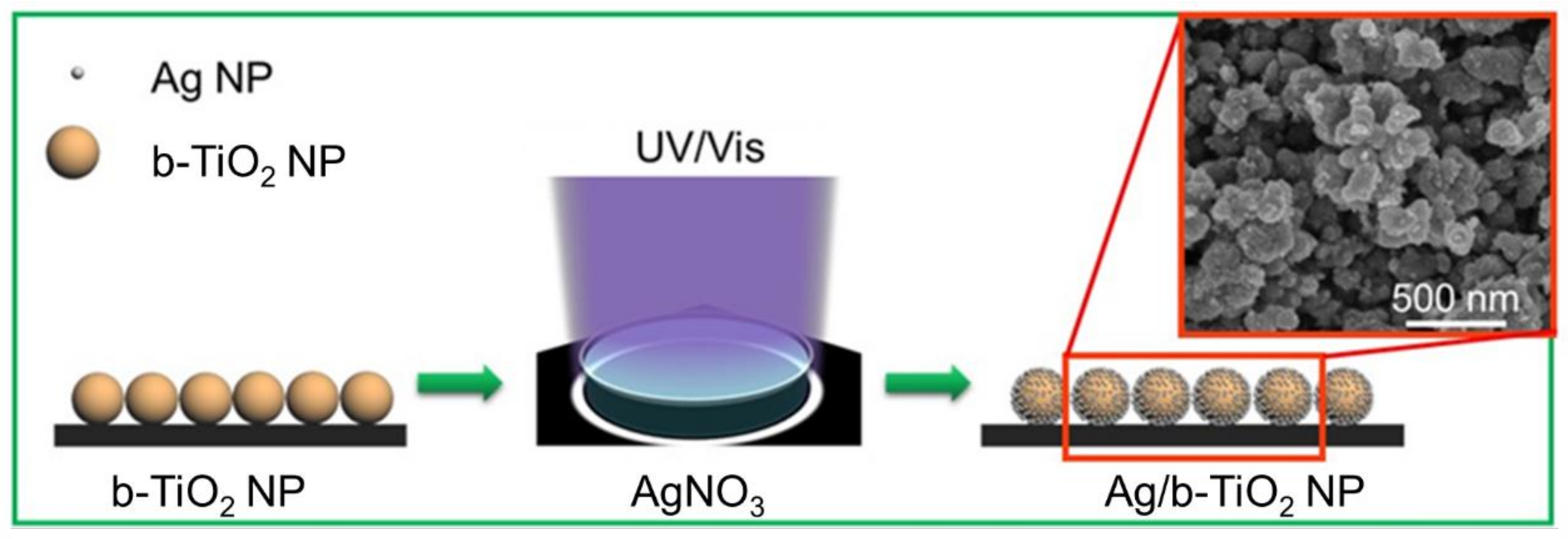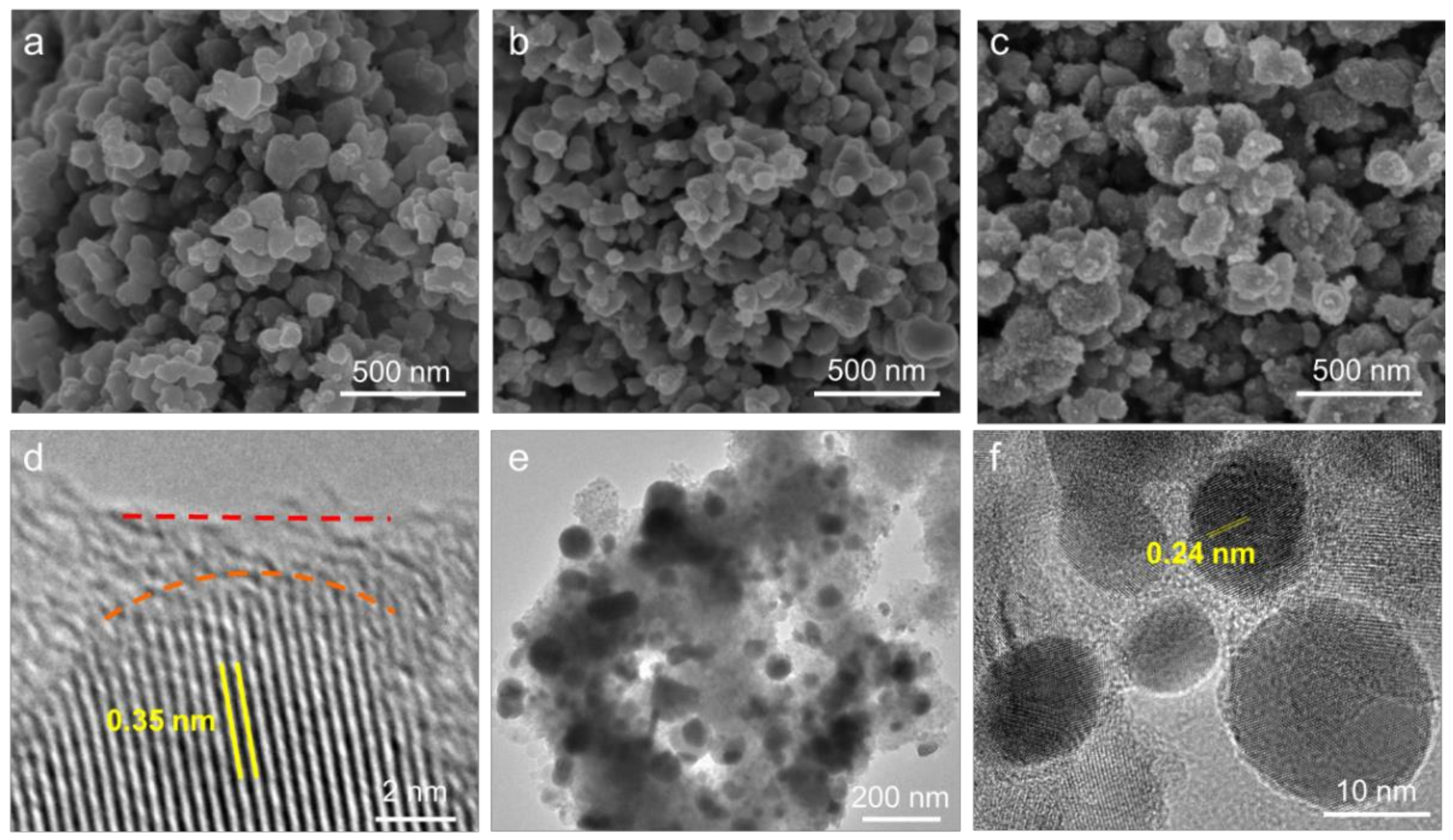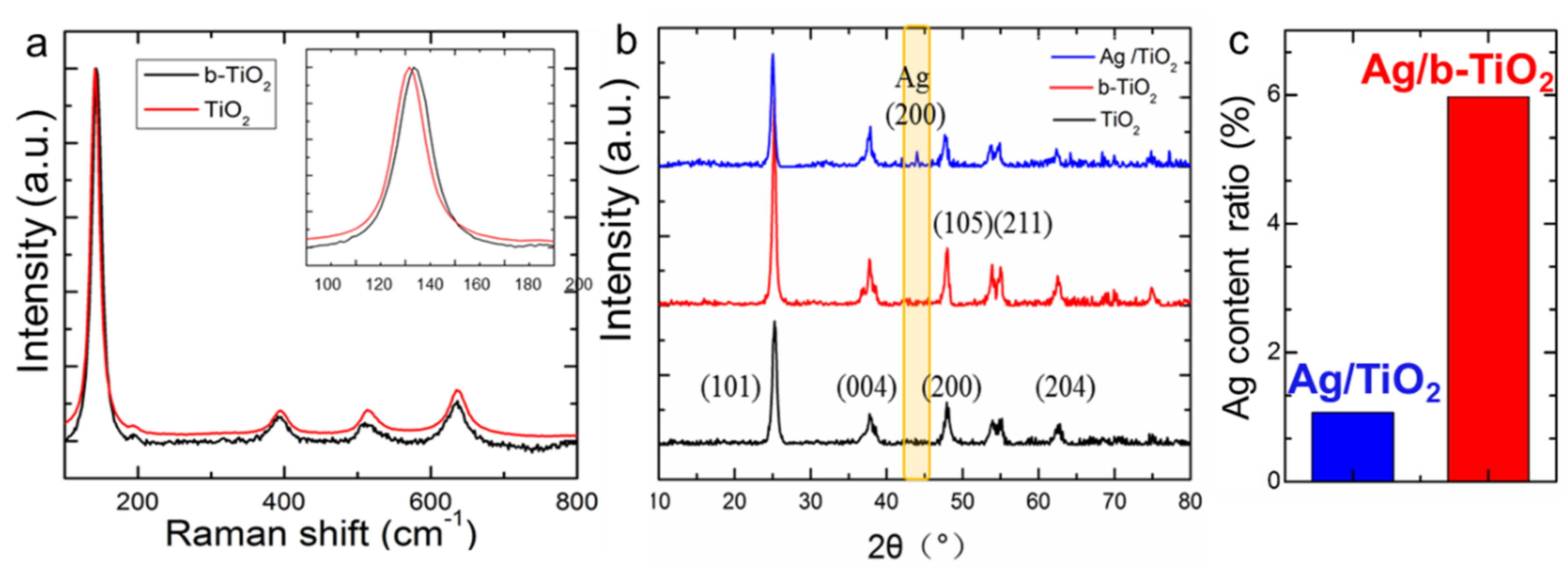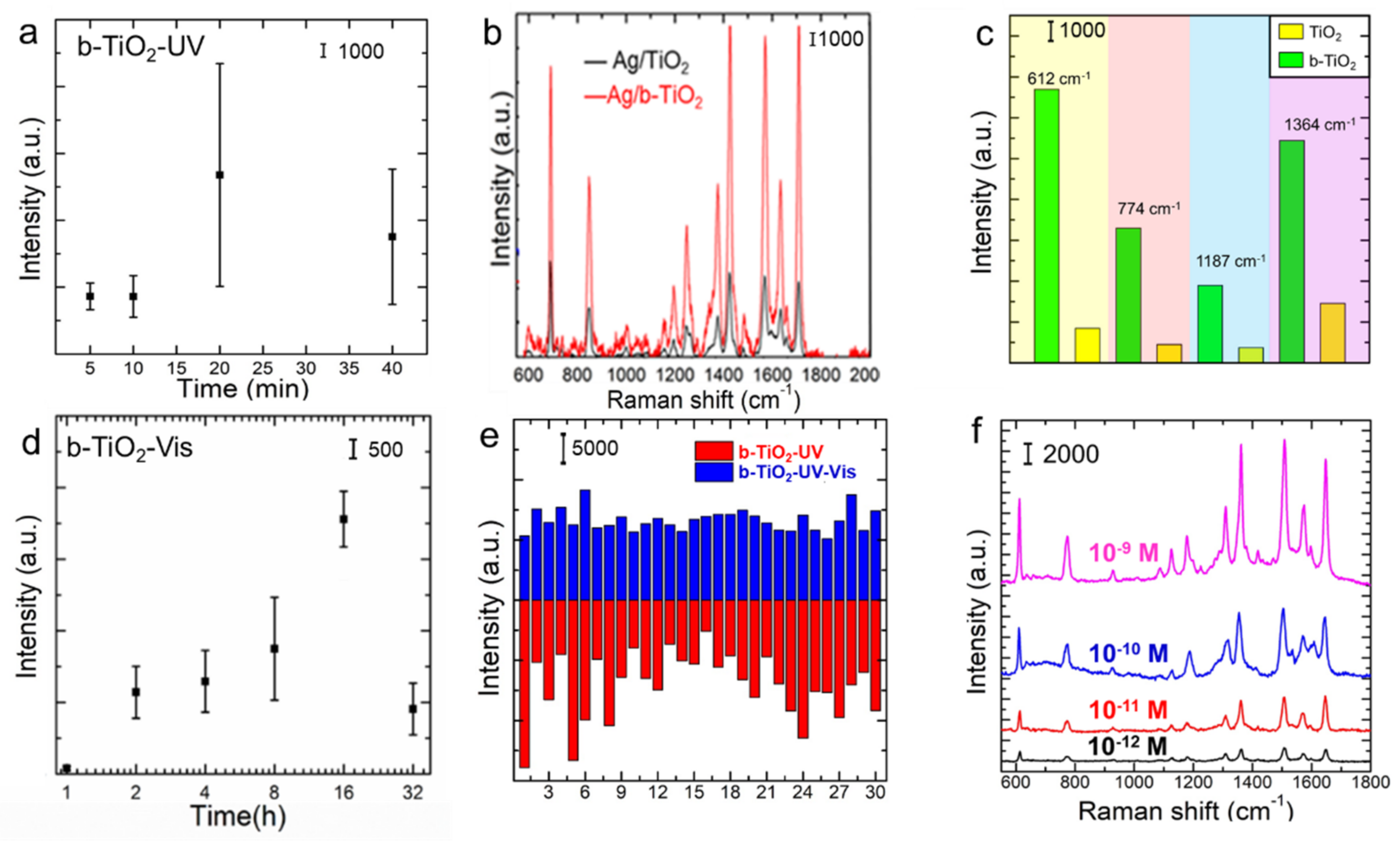Ag Nanoparticles Synthesized on Black-Titanium Dioxide by Photocatalytic Method as Reusable Substrates of Surface-Enhanced Raman Spectroscopy
Abstract
1. Introduction
2. Experimental
2.1. Materials and Instruments
2.2. Synthesis of TiO2 Samples
2.3. Synthesis of b-TiO2 Samples
2.4. Synthesis of Ag/b-TiO2-UV, Ag/b-TiO2-Vis, and Ag/b-TiO2-UV-Vis Substrates
2.5. SERS Measurement
3. Results and Discussion
4. Conclusions
Supplementary Materials
Author Contributions
Funding
Institutional Review Board Statement
Informed Consent Statement
Data Availability Statement
Conflicts of Interest
References
- Cong, T.Z.; Huang, Y.Y.; Zhao, Y.P.; Huang, H.; Zhang, D.M.; Li, C.W.; Fan, Z.; Pan, L.J. Extremely sensitive and reusable surface-enhanced Raman scattering substrate based on 3D Ag-titanium dioxide nanowires. J. Alloys Compd. 2021, 859, 158389. [Google Scholar] [CrossRef]
- Li, C.H.; Xu, S.C.; Yu, J.; Li, Z.; Li, W.F.; Wang, J.H.; Liu, A.H.; Man, B.Y.; Yang, S.K.; Zhang, C. Local hot charge density regulation: Vibration-free pyroelectric nanogenerator for effectively enhancing catalysis and in-situ surface enhanced Raman scattering monitoring. Nano Energy 2021, 81, 105585. [Google Scholar] [CrossRef]
- Liu, H.F.; Dai, E.H.; Xiao, R.; Zhou, Z.H.; Zhang, M.L.; Bai, Z.K.; Shao, Y.; Qi, K.Z.; Tu, J.; Wang, C.W.; et al. Development of a SERS-based lateral flow immunoassay for rapid and ultra-sensitive detection of anti-SARS-CoV-2 IgM/IgG in clinical samples. Sens. Actuators B Chem. 2021, 329, 129196. [Google Scholar] [CrossRef] [PubMed]
- Xu, Y.; Kutsanedzie, F.Y.H.; Hassan, M.; Zhu, J.J.; Ahmad, W.; Li, H.H.; Chen, Q.S. Mesoporous silica supported orderly-spaced gold nanoparticles SERS-based sensor for pesticides detection in food. Food Chem. 2020, 315, 126300. [Google Scholar] [CrossRef] [PubMed]
- Yang, Y.Y.; Li, Y.T.; Li, X.J.; Zhang, L.; Fodjo, E.K.; Han, S. Controllable in situ fabrication of portable AuNP/mussel-inspired polydopamine molecularly imprinted SERS substrate for selective enrichment and recognition of phthalate plasticizers. Chem. Eng. J. 2020, 402, 125179. [Google Scholar] [CrossRef]
- Santhoshkumar, S.; Murugan, E. Rationally designed SERS AgNPs/GO/g-CN nanohybrids to detect methylene blue and Hg2+ ions in aqueous solution. Appl. Surf. Sci. 2021, 553, 149544. [Google Scholar] [CrossRef]
- Zhang, J.; Xing, T.Y.; Zhang, M.; Zhou, Y.L. Facile preparation of Cu2-xS supernanoparticles with an unambiguous SERS enhancement mechanism. Chem. Eng. J. 2022, 434, 134457. [Google Scholar] [CrossRef]
- Lin, S.S.; Mandavkar, R.; Kulkarni, R.; Pandit, S.; Burse, S.; Habib, M.A.; Kunwar, S.; Lee, J. Hybridization of 2D MoS2 Nanoplatelets and PtAu Hybrid Nanoparticles for the SERS Enhancement of Methylene Blue. Adv. Mater. Interfaces 2021, 8, 2101084. [Google Scholar] [CrossRef]
- Kaushik, V.; Kagdada, H.L.; Singh, D.K.; Pathak, S. Enhancement of SERS effect in Graphene-Silver hybrids. Appl. Surf. Sci. 2022, 574, 151724. [Google Scholar] [CrossRef]
- Sun, Q.; Zhang, Q.Y.; Zhou, N.; Zhang, L.Y.; Hu, Q.; Ma, C.Y. FDTD simulation of Ag-decorated ZnO nanorods for optimization of 3D SERS substrates. Appl. Surf. Sci. 2021, 565, 151724. [Google Scholar] [CrossRef]
- Zhao, S.S.; Wang, H.L.; Niu, L.X.; Xiong, W.Q.; Chen, Y.X.; Zeng, M.Q.; Yuan, S.J.; Fu, L. 2D GaN for Highly Reproducible Surface Enhanced Raman Scattering. Small 2021, 17, 2103442. [Google Scholar] [CrossRef]
- Yin, Z.; Xu, K.C.; Jiang, S.Z.; Luo, D.; Chen, R.; Xu, C.X.; Shum, P.; Liu, Y.J. Recent progress on two-dimensional layered materials for surface enhanced Raman spectroscopy and their applications. Mater. Today Phys. 2021, 18, 100378. [Google Scholar] [CrossRef]
- Blanco-Formoso, M.; Pazos-Perez, N.; Alvarez-Puebla, R.A. Fabrication and SERS properties of complex and organized nanoparticle plasmonic clusters stable in solution. Nanoscale 2020, 12, 14948–14956. [Google Scholar] [CrossRef]
- Wang, K.Q.; Sun, D.W.; Pu, H.B.; Wei, Q.Y. Polymer multilayers enabled stable and flexible Au@Ag nanoparticle array for nondestructive SERS detection of pesticide residues. Talanta 2021, 223, 121782. [Google Scholar] [CrossRef]
- Pardehkhorram, R.; Alshawawreh, F.; Goncales, V.R.; Lee, N.A.; Tilley, R.D.; Gooding, J.J. Functionalized Gold Nanorod Probes: A Sophisticated Design of SERS Immunoassay for Biodetection in Complex Media. Anal. Chem. 2021, 93, 12954–12965. [Google Scholar] [CrossRef]
- Wang, J.; Xie, H.Y.; Ding, C.F. Designed Co-DNA-Locker and Ratiometric SERS Sensing for Accurate Detection of Exosomes Based on Gold Nanorod Arrays. ACS Appl. Mater. Inter. 2021, 13, 32837–32844. [Google Scholar] [CrossRef]
- Wang, H.; Li, K.B.; Xu, C.; Xu, S.C.; Li, G.H. Large-scale solvothermal synthesis of Ag nanocubes with high SERS activity. J. Alloys Compd. 2019, 772, 150–156. [Google Scholar] [CrossRef]
- Liu, Y.; Wu, S.H.; Du, X.Y.; Sun, J.J. Plasmonic Ag nanocube enhanced SERS biosensor for sensitive detection of oral cancer DNA based on nicking endonuclease signal amplification and heated electrode. Sens. Actuators B Chem. 2021, 338, 129854. [Google Scholar] [CrossRef]
- Cong, T.Z.; Huang, H.; Zhang, H.; Li, C.W.; Zhao, Y.P.; Fan, Z.; Pan, L.J. Fabrication of Au nanostar/MIL-101(Fe) architecture for surface-enhanced Raman scattering detections. Colloids Surf. A Physicochem. Eng. Asp. Colloid 2022, 651, 129777. [Google Scholar] [CrossRef]
- Zhang, H.N.; Huang, S.Q.; Yang, X.; Yuan, R.; Chai, Y.Q. A SERS biosensor constructed by calcined ZnO substrate with high-efficiency charge transfer for sensitive detection of Pb2+. Sens. Actuators B Chem. 2021, 343, 130142. [Google Scholar] [CrossRef]
- Wang, X.J.; Zhang, E.; Shi, H.M.; Tao, Y.F.; Ren, X.D. Semiconductor-based surface enhanced Raman scattering (SERS): From active materials to performance improvement. Analyst 2022, 147, 1257–1272. [Google Scholar] [CrossRef] [PubMed]
- Kumar, E.A.; Barveen, N.R.; Wang, T.J.; Kokulnathan, T.; Chang, Y.H. Development of SERS platform based on ZnO multipods decorated with Ag nanospheres for detection of 4-nitrophenol and rhodamine 6G in real samples. Microchem. J. 2021, 170, 106660. [Google Scholar] [CrossRef]
- Ye, F.; Ju, S.X.; Liu, Y.J.; Jiang, Y.R.; Chen, H.; Ge, L.H.; Yan, C.; Yuan, A.H. Ag-CuO Nanocomposites: Surface-Enhanced Raman Scattering Substrate and Photocatalytic Performance. Cryst. Res. Technol. 2019, 54, 1800257. [Google Scholar] [CrossRef]
- Kumar, E.A.; Wang, T.J.; Chang, Y.H. Ultrasensitive SERS substrates based on Au nanoparticles photo-decorated on Cu2O microspheres for the detection of rhodamine B and methylene blue. Appl. Surf. Sci. 2022, 585, 152696. [Google Scholar] [CrossRef]
- Barveen, N.R.; Wang, T.J.; Chang, Y.H.; Yuan-Liu, Z. Ultrasensitive and reusable SERS probe for the detection of synthetic dyes in food industry through hybrid flower-shaped ZnO@Ag nanostructures. J. Alloys Compd. 2021, 861, 157952. [Google Scholar] [CrossRef]
- Yeh, Y.J.; Liu, C.Y.; Chu, J.P.; Chiang, W.H.; Tung, K.L. Plasmonic Au loaded semiconductor-engineered large-scale metallic nanostructure arrays for SERS application. Surf. Coat. Technol. 2022, 436, 128285. [Google Scholar] [CrossRef]
- Xie, Z.; Zhao, F.T.; Zou, S.M.; Zhu, F.; Zhang, Z.J.; Wang, W.P. TiO2 nanorod arrays decorated with Au nanoparticles as sensitive and recyclable SERS substrates. J. Alloys Compd. 2021, 861, 157999. [Google Scholar] [CrossRef]
- Nakata, K.; Fujishima, A. TiO2 photocatalysis: Design and applications. J. Photochem. Photobiol. C Photochem. Rev. 2012, 13, 169–189. [Google Scholar] [CrossRef]
- Fu, X.; Pan, L.J.; Li, S.; Wang, Q.; Qin, J.; Huang, Y.Y. Controlled preparation of Ag nanoparticle films by a modified photocatalytic method on TiO2 films with Ag seeds for surface-enhanced Raman scattering. Appl. Surf. Sci. 2016, 363, 412–420. [Google Scholar] [CrossRef]
- Jing, M.Y.; Zhang, H.; Li, M.; Mao, Z.; Shi, X.M. Silver nanoparticle-decorated TiO2 nanotube array for solid-phase microextraction and SERS detection of antibiotic residue in milk. Spectrochim. Acta Part A Mol. Biomol. Spectrosc. 2021, 255, 119652. [Google Scholar] [CrossRef]
- Xu, Y.P.; Zhang, D.H.; Lin, J.; Wu, X.X.; Xu, X.W.; Akakuru, O.U.; Zhang, H.; Zhang, Z.W.; Xie, Y.J.; Wu, A.G.; et al. Ultrahigh SERS activity of the TiO2@Ag nanostructure leveraged for accurately detecting CTCs in peripheral blood. Biomater. Sci. 2022, 10, 1812–1820. [Google Scholar] [CrossRef]
- Gao, J.Q.; Xue, J.B.; Jia, S.F.; Shen, Q.Q.; Zhang, X.C.; Jia, H.S.; Liu, X.G.; Li, Q.; Wu, Y.C. Self-Doping Surface Oxygen Vacancy-Induced Lattice Strains for Enhancing Visible Light-Driven Photocatalytic H-2 Evolution over Black TiO2. ACS Appl. Mater. Int. 2021, 13, 18758–18771. [Google Scholar] [CrossRef]
- Rajaraman, T.S.; Parikh, S.P.; Gandhi, V.G. Black TiO2: A review of its properties and conflicting trends. Chem. Eng. J. 2020, 389, 123918. [Google Scholar] [CrossRef]
- Wei, W.X.; Yu, D.; Huang, Q.L. Preparation of Ag/TiO2 nanocomposites with controlled crystallization and properties as a multifunctional material for SERS and photocatalytic applications. Spectrochim. Acta A 2020, 243, 118793. [Google Scholar] [CrossRef]
- Zhang, W.; Xue, J.B.; Shen, Q.Q.; Jia, S.F.; Gao, J.Q.; Liu, X.G.; Jia, H.S. Black single-crystal TiO2 nanosheet array films with oxygen vacancy on {001} facets for boosting photocatalytic CO2 reduction. J. Alloys Compd. 2021, 870, 159400. [Google Scholar] [CrossRef]
- Zhang, D.M.; Cong, T.Z.; Xia, L.C.; Pan, L.J. Growth of black TiO2 nanowire/carbon fiber composites with dendritic structure for efficient visible-light-driven photocatalytic degradation of methylene blue. J. Mater. Sci. 2019, 54, 7576–7588. [Google Scholar] [CrossRef]
- Chen, S.H.; Wang, Y.H.; Li, J.; Hu, Z.F.; Zhao, H.; Xie, W.; Wei, Z.G. Synthesis of black TiO2 with efficient visible-light photocatalytic activity by ultraviolet light irradiation and low temperature annealing. Mater. Res. Bull. 2018, 98, 280–287. [Google Scholar] [CrossRef]
- Sun, L.; Zhao, Y.; Shang, Y.J.; Sun, C.L.; Zhou, M. The phase stability of terephthalic acid under high pressure. Chem. Phys. Lett. 2017, 689, 56–61. [Google Scholar] [CrossRef]
- Cabrera-Alonso, R.; Guevara, E.; Ramirez-Elias, M.G.; Moncada, B.; Gonzalez, F.J. Surface-enhanced Raman scattering of hydroquinone assisted by gold nanorods. J. Nanophotonics 2019, 13, 036006. [Google Scholar] [CrossRef]
- De Carvalho, D.F.; da Fonseca, B.G.; Barbosa, I.L.; Landi, S.M.; de Sena, L.A.; Archanjo, B.S.; Sant, A.C. Surface-enhanced Raman scattering study of the redox adsorption of p-phenylenediamine on gold or copper surfaces. Spectrochim. Acta Part A Mol. Biomol. Spectrosc. 2013, 103, 108–113. [Google Scholar] [CrossRef]
- Singh, N.; Prakash, J.; Misra, M.; Sharma, A.; Gupta, R.K. Dual Functional Ta-Doped Electrospun TiO2 Nanofibers with Enhanced Photocatalysis and SERS Detection for Organic Compounds. ACS Appl. Mater. Interfaces 2017, 9, 28495–28507. [Google Scholar] [CrossRef] [PubMed]
- Andronic, L.; Enesca, A. Black TiO2 Synthesis by Chemical Reduction Methods for Photocatalysis Applications. Front. Chem. 2020, 8, 565489. [Google Scholar] [CrossRef] [PubMed]
- Lombardi, J.R.; Birke, R.L. A unified approach to surface-enhanced Raman spectroscopy. J. Phys. Chem. C 2008, 112, 5605–5617. [Google Scholar] [CrossRef]
- Xue, X.X.; Chen, L.; Wang, C.X.; Zhao, C.M.; Wang, H.R.; Ma, N.; Li, J.H.; Qiao, Y.; Chang, L.M.; Zhao, B. Highly sensitive SERS behavior and wavelength-dependence charge transfer effect on the PS/Ag/ZIF-8 substrate. Spectrochim. Acta Part A Mol. Biomol. Spectrosc. 2021, 247, 119126. [Google Scholar] [CrossRef] [PubMed]
- VandeVondele, J.; Krack, M.; Mohamed, F.; Parrinello, M.; Chassaing, T.; Hutter, J. QUICKSTEP: Fast and accurate density functional calculations using a mixed Gaussian and plane waves approach. Comput. Phys. Commun. 2005, 167, 103–128. [Google Scholar] [CrossRef]
- Lippert, G.; Hutter, J.; Parrinello, M. A hybrid Gaussian and plane wave density functional scheme. Mol. Phys. 1997, 92, 477–487. [Google Scholar] [CrossRef]
- Hutter, J.; Iannuzzi, M.; Schiffmann, F.; VandeVondele, J. CP2K: Atomistic simulations of condensed matter systems. Wiley Interdiscip. Rev. Comput. Mol. Sci. 2014, 4, 15–25. [Google Scholar] [CrossRef]
- VandeVondele, J.; Hutter, J. An efficient orbital transformation method for electronic structure calculations. J. Chem. Phys. 2003, 118, 4365–4369. [Google Scholar] [CrossRef]
- Kuhne, T.D.; Iannuzzi, M.; Del Ben, M.; Rybkin, V.V.; Seewald, P.; Stein, F.; Laino, T.; Khaliullin, R.Z.; Schutt, O.; Schiffmann, F.; et al. CP2K: An electronic structure and molecular dynamics software package—Quickstep: Efficient and accurate electronic structure calculations. J. Chem. Phys. 2020, 152, 194103. [Google Scholar] [CrossRef]
- Perdew, J.P.; Burke, K.; Ernzerhof, M. Generalized gradient approximation made simple (vol 77, pg 3865, 1996). Phys. Rev. Lett. 1997, 78, 1396. [Google Scholar] [CrossRef]
- Grimme, S.; Antony, J.; Ehrlich, S.; Krieg, H. A consistent and accurate ab initio parametrization of density functional dispersion correction (DFT-D) for the 94 elements H-Pu. J. Chem. Phys. 2010, 132, 154104. [Google Scholar] [CrossRef]
- Goedecker, S.; Teter, M.; Hutter, J. Separable dual-space Gaussian pseudopotentials. Phys. Rev. B. 1996, 54, 1703–1710. [Google Scholar] [CrossRef]
- Hartwigsen, C.; Goedecker, S.; Hutter, J. Relativistic separable dual-space Gaussian pseudopotentials from H to Rn. Phys. Rev. B 1998, 58, 3641–3662. [Google Scholar] [CrossRef]
- Huang, Y.-F.; Chen, C.-Y.; Chen, L.-C.; Chen, K.-H.; Chattopadhyay, S. Plasmon management in index engineered 2.5D hybrid nanostructures for surface-enhanced Raman scattering. NPG Asia Mater. 2014, 6, e123. [Google Scholar] [CrossRef]
- Kumar, S.; Cherukulappurath, S.; Johnson, T.W.; Oh, S.-H. Millimeter-Sized Suspended Plasmonic Nanohole Arrays for Surface-Tension-Driven Flow-Through SERS. Chem. Mater. 2014, 26, 6523–6530. [Google Scholar] [CrossRef]
- Theiss, J.; Pavaskar, P.; Echternach, P.M.; Muller, R.E.; Cronin, S.B. Plasmonic Nanoparticle Arrays with Nanometer Separation for High-Performance SERS Substrates. Nano Lett. 2010, 10, 2749–2754. [Google Scholar] [CrossRef]
- Yang, S.; Slotcavage, D.; Mai, J.; Guo, F.; Li, S.; Zhao, Y.; Lei, Y.; Cameron, C.E.; Huang, T.J. Electrochemically created highly surface roughened Ag nanoplate arrays for SERS biosensing applications. J. Mater. Chem. C 2014, 2, 8350–8356. [Google Scholar] [CrossRef]
- Shan, D.; Huang, L.; Li, X.; Zhang, W.; Wang, J.; Cheng, L.; Feng, X.; Liu, Y.; Zhu, J.; Zhang, Y. Surface Plasmon Resonance and Interference Coenhanced SERS Substrate of AAO/Al-Based Ag Nanostructure Arrays. J. Phys. Chem. C 2014, 118, 23930–23936. [Google Scholar] [CrossRef]
- Sun, G.; Fu, C.; Dong, M.; Jin, G.; Song, Q. The finite-difference time-domain (FDTD) guided preparation of Ag nanostructures on Ti substrate for sensitive SERS detection of small molecules. Spectrochim. Acta Part A Mol. Biomol. Spectrosc. 2021, 269, 120743. [Google Scholar] [CrossRef]
- Jin, J.; Song, W.; Wang, J.; Li, L.; Tian, Y.; Zhu, S.; Zhang, Y.; Xu, S.; Yang, B.; Zhao, B. A highly sensitive SERS platform based on small-sized Ag/GQDs nanozyme for intracellular analysis. Chem. Eng. J. 2021, 430, 132687. [Google Scholar] [CrossRef]
- Jia, K.; Xie, J.; He, X.; Zhang, D.; Hou, B.; Li, X.; Zhou, X.; Hong, Y.; Liu, X. Polymeric micro-reactors mediated synthesis and assembly of Ag nanoparticles into cube-like superparticles for SERS application. Chem. Eng. J. 2020, 395, 125123. [Google Scholar] [CrossRef]






Publisher’s Note: MDPI stays neutral with regard to jurisdictional claims in published maps and institutional affiliations. |
© 2022 by the authors. Licensee MDPI, Basel, Switzerland. This article is an open access article distributed under the terms and conditions of the Creative Commons Attribution (CC BY) license (https://creativecommons.org/licenses/by/4.0/).
Share and Cite
Cong, T.; Zhang, Y.; Huang, H.; Li, C.; Fan, Z.; Pan, L. Ag Nanoparticles Synthesized on Black-Titanium Dioxide by Photocatalytic Method as Reusable Substrates of Surface-Enhanced Raman Spectroscopy. Chemosensors 2022, 10, 441. https://doi.org/10.3390/chemosensors10110441
Cong T, Zhang Y, Huang H, Li C, Fan Z, Pan L. Ag Nanoparticles Synthesized on Black-Titanium Dioxide by Photocatalytic Method as Reusable Substrates of Surface-Enhanced Raman Spectroscopy. Chemosensors. 2022; 10(11):441. https://doi.org/10.3390/chemosensors10110441
Chicago/Turabian StyleCong, Tianze, Yifeng Zhang, Hui Huang, Chengwei Li, Zeng Fan, and Lujun Pan. 2022. "Ag Nanoparticles Synthesized on Black-Titanium Dioxide by Photocatalytic Method as Reusable Substrates of Surface-Enhanced Raman Spectroscopy" Chemosensors 10, no. 11: 441. https://doi.org/10.3390/chemosensors10110441
APA StyleCong, T., Zhang, Y., Huang, H., Li, C., Fan, Z., & Pan, L. (2022). Ag Nanoparticles Synthesized on Black-Titanium Dioxide by Photocatalytic Method as Reusable Substrates of Surface-Enhanced Raman Spectroscopy. Chemosensors, 10(11), 441. https://doi.org/10.3390/chemosensors10110441






